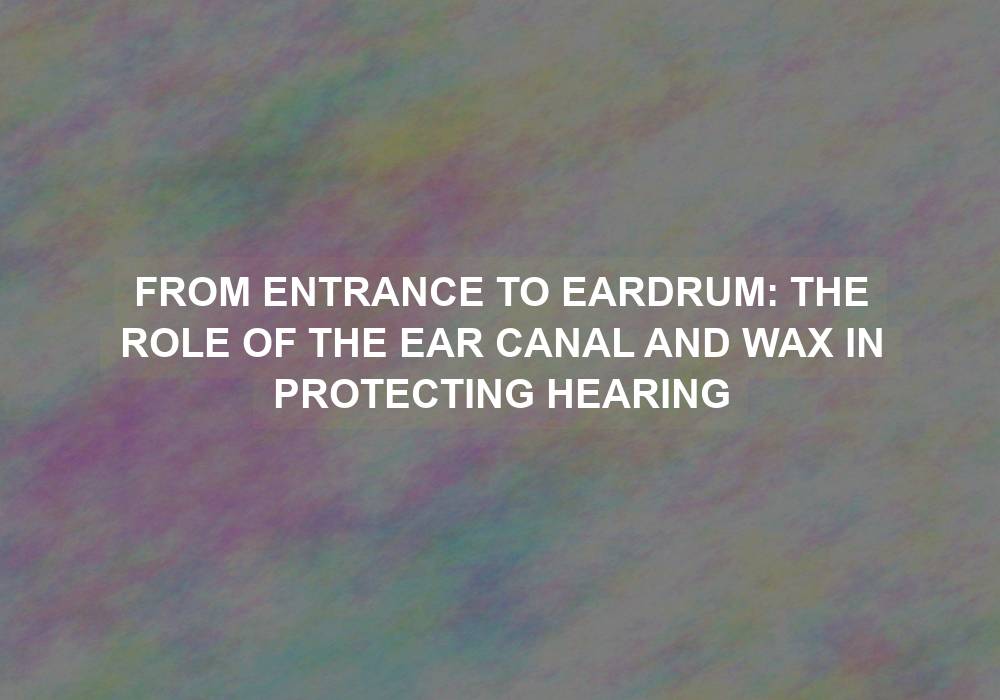The human ear is an incredible organ responsible for our sense of hearing. It consists of several parts, including the outer ear, middle ear, and inner ear. One crucial component that often goes unnoticed is the ear canal and the wax produced within it. In this article, we will delve into the significance of the ear canal and wax in protecting our hearing.
The Anatomy of the Ear
Before we explore the role of the ear canal and wax, let’s briefly understand the anatomy of the ear. The outer ear is the visible part that includes the pinna, the fleshy structure we commonly refer to as the ear. This pinna collects sound waves and directs them into the ear canal, also known as the external auditory canal.
The ear canal is a tubular structure that extends from the pinna to the eardrum. It is lined with specialized skin and small hairs called cilia. At the end of the ear canal lies the eardrum, a thin membrane that separates the outer ear from the middle ear.
The Importance of the Ear Canal
The ear canal plays a vital role in transmitting sound waves from the outer ear to the middle ear. As sound waves enter the ear canal, they travel towards the eardrum, causing it to vibrate. These vibrations are then passed on to the tiny bones within the middle ear, initiating the process of hearing.
In addition to sound transmission, the ear canal also acts as a natural barrier, protecting the delicate parts of the ear from foreign objects such as dust, insects, and debris. The narrow and curved structure of the ear canal helps prevent these objects from entering and causing damage to the eardrum or other components of the ear.
Furthermore, the ear canal is responsible for regulating the temperature and moisture within the ear. The specialized skin lining the ear canal produces cerumen, commonly known as earwax, which helps maintain an optimal environment. Earwax acts as a protective barrier, preventing the ear canal from becoming too dry or too moist.
The Role of Earwax
Earwax, despite being often seen as a nuisance, actually serves several essential purposes in protecting our hearing. Let’s take a closer look at the role of earwax:
Lubrication and Moisturization
Earwax contains natural oils that help lubricate and moisturize the ear canal. By doing so, it prevents dryness and itching, ensuring the skin remains healthy and free from irritation.
Trapping Foreign Particles
Earwax acts as a sticky trap, capturing dust, dirt, and other small particles that may enter the ear canal. This mechanism prevents these foreign objects from reaching the delicate components of the ear, such as the eardrum.
Antibacterial and Antifungal Properties
Research suggests that earwax possesses antibacterial and antifungal properties that help protect the ear from potential infections. These properties inhibit the growth of harmful microorganisms, reducing the risk of ear-related ailments.
Self-Cleaning Mechanism
The ear canal has a self-cleaning mechanism facilitated by the movement of the jaw during activities like talking and chewing. As the jaw moves, it helps push the earwax towards the outer ear, naturally eliminating any excess buildup. This process prevents the accumulation of earwax and maintains a healthy balance.
Proper Ear Canal Care
While earwax is beneficial, excessive buildup can lead to discomfort and hearing problems. Therefore, it is important to adopt proper ear canal care practices. Here are some tips:
- Avoid Q-tip Usage: Contrary to popular belief, using Q-tips or inserting any objects into the ear canal can do more harm than good. It can push the earwax deeper, leading to impaction or damage to the eardrum.
- Let Nature Take Its Course: The self-cleaning mechanism of the ear usually takes care of removing excess earwax. Allowing the earwax to naturally migrate towards the outer ear is the best approach.
- Seek Professional Help: If you experience symptoms like ear pain, hearing loss, or excessive earwax buildup, it is advisable to consult a healthcare professional. They can safely remove the excess wax or provide guidance on proper ear care.
Conclusion
The ear canal and the wax it produces play a crucial role in protecting our hearing. From facilitating sound transmission to acting as a natural defense against foreign objects, they contribute significantly to the overall health of our ears. Understanding the importance of proper ear care and avoiding common misconceptions is essential in maintaining good hearing health. So, let us appreciate the intricate mechanisms of our ears and take the necessary steps to protect them.
